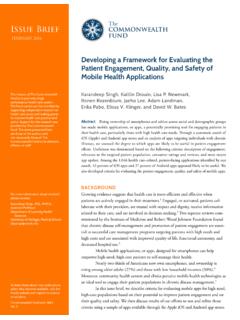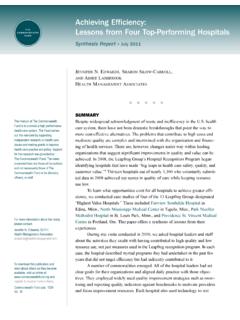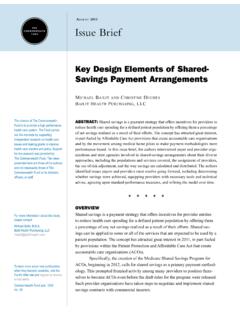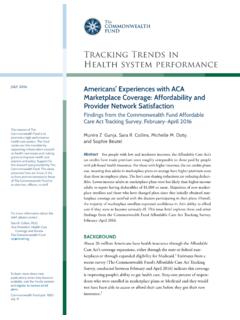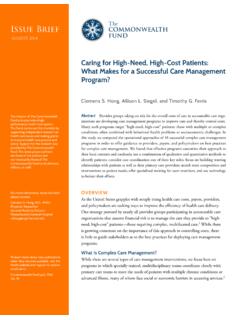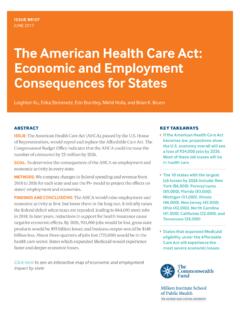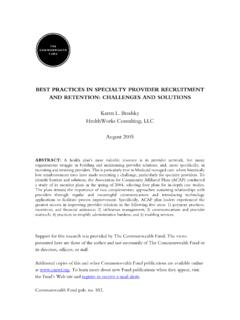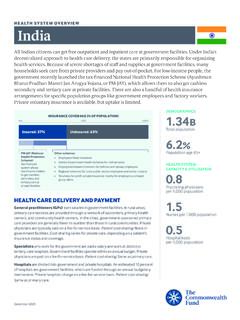Transcription of Montefiore Medical Center: Integrated Care Delivery for ...
1 Case StudyHigh-Performing Health Care Organization March 2009 The mission of The Commonwealth Fund is to promote a high performance health care system. The Fund carries out this mandate by supporting independent research on health care issues and making grants to improve health care practice and policy. Support for this research was provided by The Commonwealth Fund. The views presented here are those of the author and not necessarily those of The Commonwealth Fund or its directors, officers, or more information about this study, please contact:Deborah Chase, Research, learn more about new publications when they become available, visit the Fund's Web site and register to receive e-mail Fund pub. 1448 Vol. 53 Montefiore Medical Center: Integrated Care Delivery for Vulnerable PopulationsDeborah Chase, Issues researCh, : Montefiore Medical Center, an academic Medical center in New York City, has created an Integrated system of care for its primarily low-income patients.
2 This patient-centered system of hospitals, community clinics, and school-based clinics uses innovative practices for managing chronic disease, provides access to high-quality specialty hospital care, and employs targeted care management and robust health information technology in support of Integrated care. Although close to 80 percent of its payer mix is Medicaid and Medicare, Montefiore has been able to achieve financial and organizational sustain-ability. Factors that contribute to this success include: care management that allows for integration across the system; building successful primary care that combines traditional and new models; and Medical systems that focus on population health and community accountability.
3 OVERVIEWThe health care safety net serves a critical role in ensuring that America s most vulnerable populations those with low incomes and those without health insurance receive both emergency and ongoing care. According to the Institute of medicine (IOM), however, there is a growing disparity between high-performing, economically successful safety-net providers and the larger group of struggling The IOM has also cited a need for increased fed-eral tracking of the changes in the health care safety To address this gap, The Commonwealth Fund has increased its efforts to study the safety net to identify examples of high-performing systems and to offer a broader look at emerging strategies for delivering, financing, and managing care for vulnerable This case study describes how Montefiore Medical Center, a not-for-profit academic Medical center in the Bronx borough of New York City, has cre-ated a patient-centered system of care that tailors its access, Delivery .
4 And infor-Case StudyIntegrated Safety-Net Health Care System October 20102 The CoMMonwealTh FunDmation systems to the unique needs of the primarily low-income, vulnerable populations it serves. In recent years, the Medical center has sharpened its focus on the needs of the community and the patient and redou-bled its emphasis on performance improvement. At the same time, Montefiore has achieved financial stability. These achievements have been realized in a commu-nity where one of four adults is uninsured, most patients have low incomes and complex needs, and insurance coverage is predominantly through Medicaid and Medicare (which together make up more than 75 percent of system revenues). Specifically, the innova-tions undertaken by Montefiore : focus on better management of chronic diseases through ambulatory and primary care strategies that extend access to multiple points in the com-munity; provide access to high-quality specialty and hospi-tal care.
5 And create greater integration of care Delivery through the application of targeted care management and robust health information is hoped that the insights offered in this case study will be useful to safety-net systems, aca-demic Medical centers, and other stakeholders as they struggle to deliver and finance care for vulnerable S COMMUNITY, STRUCTURE, AND ORGANIZATIONE stablished in 1884 as a hospital for patients with chronic illnesses, most notably tuberculosis, Montefiore Medical Center serves 500,000 residents of the Bronx and adjacent Westchester County. The Bronx is one of the poorest urban counties in the nation, where one-quarter of the adult population is uninsured and carry the burdens of disease associated with poverty: obesity, hypertension, cardiovascular disease, asthma, hepatitis C, and HIV.
6 More than 400,000 of the Bronx s approximately million resi-dents are children, almost half of all residents identify themselves as Latino/Hispanic, and nearly 36 percent identify themselves as African American (Exhibit 1). In addition, hundreds of thousands of undocumented persons live in the evident in its stated mission, vision, and values, Montefiore addresses the intense challenges Exhibit 1. Selected Population Characteristics for the Bronx and New York CityIndicatorBronxNew York CityPoor or fair healthLow birthweightTeen birth rate (per 1,000)Uninsured adultsChildren in povertySingle-parent householdsBlack or African AmericanHispanic or LatinoDisabledSpeak language other than English at homeMedian family incomeFamilies below poverty level27% $30,68228%16% $50, : County Health Rankings, Snapshot 2010: Bronx, Census Bureau, American FactFinder, Medical CenTer.
7 Integrated Care Delivery For vulnerable PoPulaTIons 3faced by its patient population through a commitment to patient-centered care that meets the access challenges and social needs of vulnerable Montefiore s size makes innovation and integration difficult, it also gives the system the power to reach thousands of patients. The system includes four hospitals, with a total of 1,491 beds: Henry and Lucy Moses Division (620 beds); Jack D. Weiler Hospital and albert einstein college of medicine (396 beds); Children s Hospital of Montefiore (106 beds); and North Division, acquired in 2007 (369 beds). These four hospitals account for 86,500 inpatient discharges, 301,000 emergency department visits, and 7,100 births also includes 21 community-based primary care clinics (including five federally qualified health centers) that are located throughout the borough and provide 830,000 visits annually; 17 school-based clinics that provide Medical , mental health, and dental services, with a total of 65,000 annual visits to 40 schools (many schools, particularly high schools, are clustered at the same site); and a care management organization with 150,000 enrollees in capitated contracts that provide a fixed payment per enrollee.
8 Exhibit 2 provides a map showing the location, type, and penetration of Montefiore services in the Bronx and Westchester employs 17,382 staff, including 3,070 nurses, 1,625 physicians, and 1,200 Medical residents and fellows. There are an additional 1,000 voluntary (independent, community-based) physicians on staff. The health system employs the faculty of albert einstein college of medicine , who practice, teach, and conduct research. The albert einstein college of medicine , founded with a commitment to biomedical science, education, and social justice, has been affiliated with Montefiore since 1967. In 2009, a new 10-year affiliation agreement was signed between Montefiore and the Medical school, with the goal of creating an institutional partnership that aligns teaching and research the poor and elderly patient population it serves, Montefiore is heavily dependent on government coverage programs for financial stability.
9 Medicare accounts for 39 percent of Montefiore s patient volume, and Medicaid accounts for 40 percent. (In 2007, most safety-net hospitals relied on Medicaid funding for approximately 33 percent of their patient volume,4 according to the National Association of Public Hospitals.) Self-pay patients constitute 1 percent of inpatient care and 7 percent of ambulatory care volume. The remaining volume comes from a commercially insured population, including many New York City employees and labor union members. The system receives no direct subsidies from federal, state, or municipal governments. Its total disproportionate share hospital payments federal funds provided to preserve access to care for elderly and low-income populations by financially assisting the hospitals they use are approximately $145 million annually: $100 million from Medicare and $45 million from such a high proportion of lower-income, medically complex, and government-insured patients, safety-net hospitals often struggle just to break even.
10 In contrast, Montefiore has been able, despite its challenges, to achieve a positive financial position: in 2009 the system had an operating margin of percent and a total margin of percent. Montefiore president and CEO Steven Safyer, , attributes the success to efficiencies, innovation, the depth and breadth of specialty services, and patient-centered care. Montefiore s average inpatient length of stay has dropped from days in 1993 to days in 2009, compared with days for New York State hospitals and days for New York City Medical Center s Mission, Vision, and ValuesMission: To heal, to teach, to discover, and to advance the health of the communities they serveVision: To be a premier academic Medical center that transforms health and enriches livesValues: Humanity, innovation, teamwork, diversity, and equity Source.
